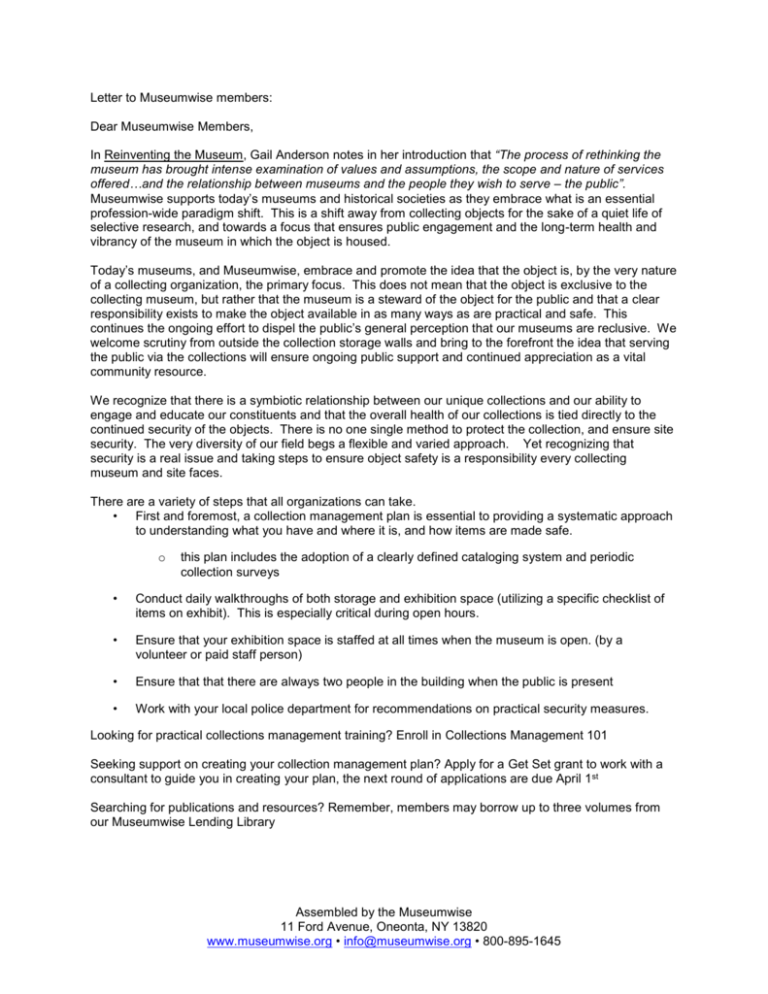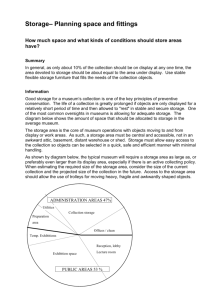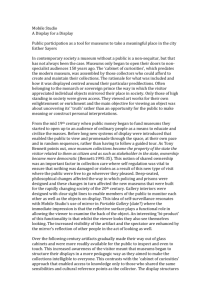Letter to UHA members: - Museumwise: The Museum Association of
advertisement

Letter to Museumwise members: Dear Museumwise Members, In Reinventing the Museum, Gail Anderson notes in her introduction that “The process of rethinking the museum has brought intense examination of values and assumptions, the scope and nature of services offered…and the relationship between museums and the people they wish to serve – the public”. Museumwise supports today’s museums and historical societies as they embrace what is an essential profession-wide paradigm shift. This is a shift away from collecting objects for the sake of a quiet life of selective research, and towards a focus that ensures public engagement and the long-term health and vibrancy of the museum in which the object is housed. Today’s museums, and Museumwise, embrace and promote the idea that the object is, by the very nature of a collecting organization, the primary focus. This does not mean that the object is exclusive to the collecting museum, but rather that the museum is a steward of the object for the public and that a clear responsibility exists to make the object available in as many ways as are practical and safe. This continues the ongoing effort to dispel the public’s general perception that our museums are reclusive. We welcome scrutiny from outside the collection storage walls and bring to the forefront the idea that serving the public via the collections will ensure ongoing public support and continued appreciation as a vital community resource. We recognize that there is a symbiotic relationship between our unique collections and our ability to engage and educate our constituents and that the overall health of our collections is tied directly to the continued security of the objects. There is no one single method to protect the collection, and ensure site security. The very diversity of our field begs a flexible and varied approach. Yet recognizing that security is a real issue and taking steps to ensure object safety is a responsibility every collecting museum and site faces. There are a variety of steps that all organizations can take. • First and foremost, a collection management plan is essential to providing a systematic approach to understanding what you have and where it is, and how items are made safe. o this plan includes the adoption of a clearly defined cataloging system and periodic collection surveys • Conduct daily walkthroughs of both storage and exhibition space (utilizing a specific checklist of items on exhibit). This is especially critical during open hours. • Ensure that your exhibition space is staffed at all times when the museum is open. (by a volunteer or paid staff person) • Ensure that that there are always two people in the building when the public is present • Work with your local police department for recommendations on practical security measures. Looking for practical collections management training? Enroll in Collections Management 101 Seeking support on creating your collection management plan? Apply for a Get Set grant to work with a consultant to guide you in creating your plan, the next round of applications are due April 1st Searching for publications and resources? Remember, members may borrow up to three volumes from our Museumwise Lending Library Assembled by the Museumwise 11 Ford Avenue, Oneonta, NY 13820 www.museumwise.org • info@museumwise.org • 800-895-1645 In light of the recent news and discussion on thefts at museums and historical societies in NY we thought this might be an opportunity to share some museum security resources and start a discussion on how we can best protect our collections. Below are some resources drawn from the American Association of Museums & Minnesota Historical Society to get us started: Theft The Association of College & Research Libraries (a division of the American Library Association) issued Guidelines Regarding Theft in Libraries. The guidelines outline ways to prevent theft and steps to take after a theft has been discovered. An appendix has a list of networking resources for protection and recovery. http://www.ala.org/ala/mgrps/divs/acrl/standards/guidelinesregardingthefts.cfm The Museum Security Network has an article on Surviving a Collection Loss: Working with Law Enforcement. It offers tips to prevent loss and actions to take after a theft to assist in recovering the property. It also offers a compilation of agencies and websites for reporting stolen property http://www.museum-security.org/donh.htm http://www.museum-security.org/ Security The American Society for Industrial Security provides General Security Risk Assessment Guidelines (PDF). This 26-page document outlines a 7-step process for identifying security risks and developing appropriate solutions. Though not specific to museums, the principles are applicable. It includes a glossary of terms, a process flow chart, and a bibliography. http://www.tisp.org/index.cfm?pk=download&id=10948&pid=10261 The Museums, Libraries and Archives Council (UK) offers Security in Museums, Archives and Libraries: A Practical Guide (PDF). This 182-page comprehensive publication addresses building security, alarms, retail security, personal security, bag searches, key control, operating procedures, contractors, couriers, security staff, and crisis management planning. It includes sample forms for reporting incidents and crimes. It also has information about the government indemnity program that is specific to the UK. The Council partners with other cultural organizations to present Collections Link, a website with practical advice and short fact sheets on security topics, such as the use of CCTV, advice for architects and planners, and display cases. http://www.collectionslink.org.uk/take_care_of_security The Northeast Document Conservation Center has a technical leaflet on Collections Security: Planning and Prevention for Libraries & Archives. It discusses strategies for preventing theft and vandalism of collections, responding to a breach of security, and creating an effective security plan. It includes a sample patron registration form, a sample procedures information sheet, and a lengthy bibliography. http://www.nedcc.org/resources/leaflets/3Emergency_Management/11CollectionsSecurity.php Risk Management The Minnesota Historical Society offers a technical leaflet to assist small museums in developing a risk management program (PDF). It includes checklists with essential elements for 8 program areas, including insurance, guards, fire protection, security, and locks & keys. Museum Security has a good website for coordinating all the websites that track stolen museum property: http://www.museum-security.org/reporting_stolen_property.html Assembled by the Museumwise 11 Ford Avenue, Oneonta, NY 13820 www.museumwise.org • info@museumwise.org • 800-895-1645 Here are the suggestions provided by the Minnesota Historical Society 1. You can’t stop a determined thief, so most measures really only serve to keep the honest people honest. Due diligence is to be expected in the matter of security. 2. The institution has an obligation to consider security: both to ensure that future generations have access to history, and to ensure that volunteers, staff, and visitors all have a safe experience. 3. Think about the collections as two groups: those that are truly irreplaceable with great associated stories and those things that are simply old without much provenance. Expend more energy on the security of the truly irreplaceable. 4. Seven Low-Tech, Mostly Low-Cost, Anti-Theft Security Strategies: a. Symbols of authority: for volunteers and staff onsite, wear a uniform item (like a polo shirt, jacket, ball cap, etc.) with other visible symbols (like a badge, key on a lanyard, a walkie-talkie on a belt, etc.) Honest people have respect for authority, and an authority figure nearby will inspire continued honesty and a sense of safety (i.e., the visitor knows who to contact/trust if something happens). All who work onsite should have training in what to do, and where to go for help. b. Intuition: look all of your visitors in the eye, befriend them, and observe body language. Not only is it polite to ask people about themselves, where they come from, and how they heard of your museum, all of these things are clues should something terrible happen (not to mention this should help with the museum’s marketing plan, too). If you are uncomfortable, there’s probably a reason. Don’t panic, but do keep an eye on the situation and know where the nearest help is. c. Positive message: educate visitors on why security is in place, should they ask, without leveling accusation or giving away the security secrets. Basic goal here is to inspire confidence in the visitor that the facility says safety for collections and people is Job #1. d. Amenities: have a designated secure place for coats and bags, and insist your visitors make use of this amenity. e. Exhibit furniture: Small things that fit in pockets should not be left out in the open. Using platforms, reading rails, and other exhibit furniture can often be used to deter the otherwise honest because they create boundaries. f. Lighting: motion activated switches in exhibit galleries not only save energy and prolong the life of objects, they do give a sense to people that their movements are noted. Spotlights also create a sense of boundaries. Grants are often available to improve lighting, such as from power companies. g. Décor: nicer finishes in truly public areas should contrast with more utilitarian finishes in nonpublic areas. When someone inadvertently wanders into a secure area, the décor will cause a certain level of self consciousness in honest people. 5. Think about a response protocols: which law enforcement agency will you call and what is their number? List out everything that should be done when a security risk arises, who should do that task, and how to document the event. 6. Never go it alone when a situation arises: call for help. 7. Never admit fault when the event happens. 8. If something is stolen, file a police report. While this may seem like bad press, without a report, securing the return of the item becomes more difficult should it surface. And, by filing a report the institution demonstrates to the public that it takes its responsibility to collections seriously, and therefore potential donations should also be safe. Assembled by the Museumwise 11 Ford Avenue, Oneonta, NY 13820 www.museumwise.org • info@museumwise.org • 800-895-1645





